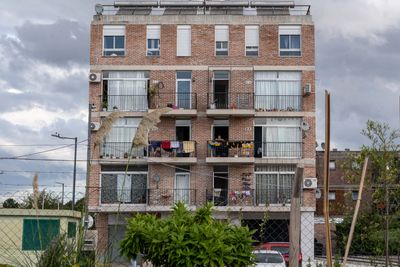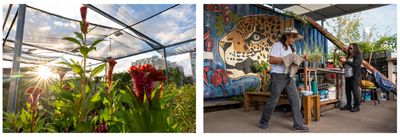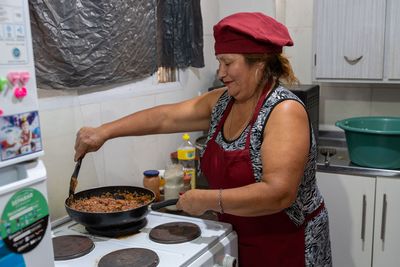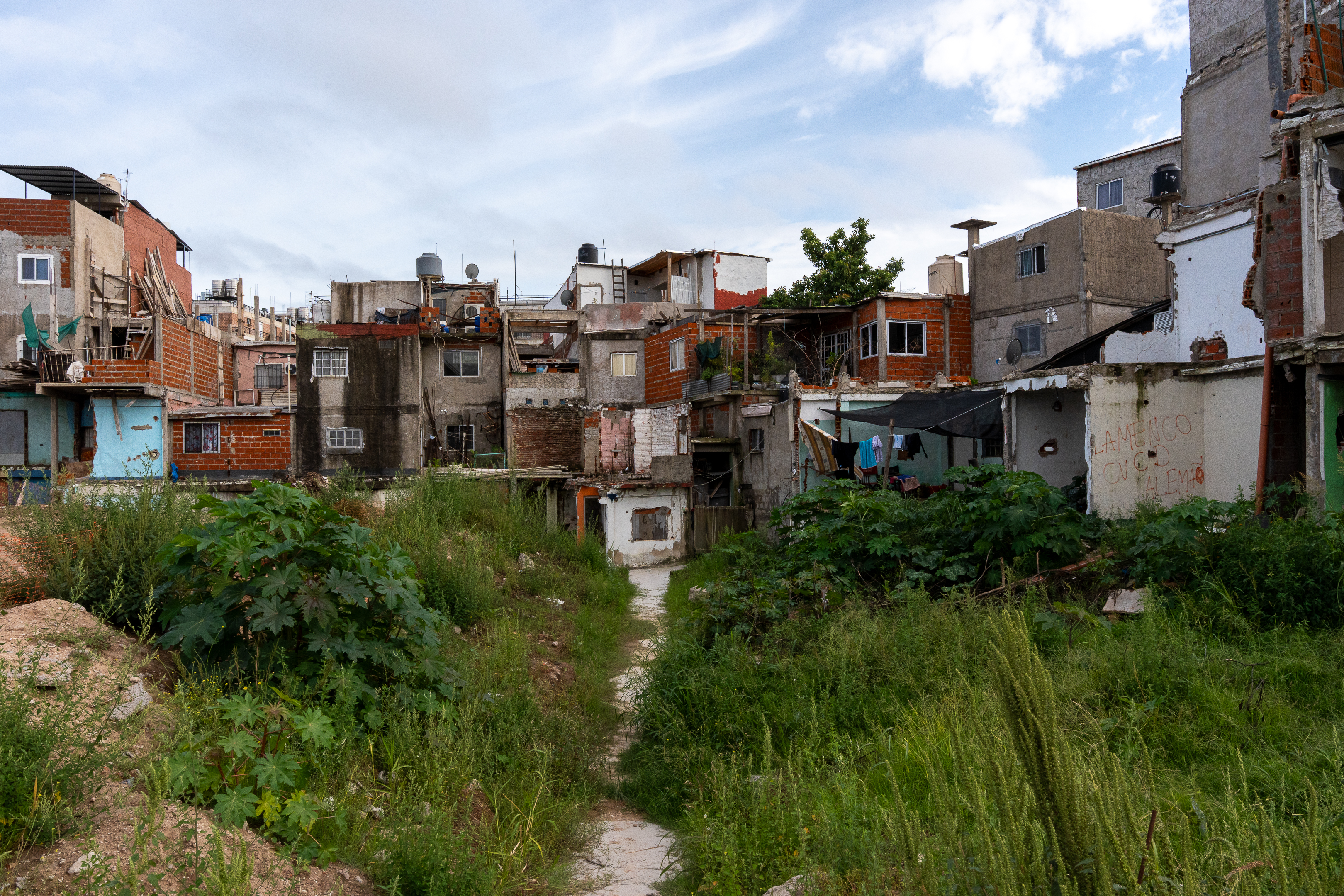In a suburb of Buenos Aires, Argentina, dirt roads surround a two-sided Argentine neighborhood contrasted by the sole divide of one street – Yma Sumac. Named after a Peruvian singer, her name means “how beautiful” in Quechua.
On the left side of Yma Sumac, the red and white brick walls and roofs are dilapidated. Some families living there do not have a roof over their heads. Their only form of protection in bad weather is a black mesh tarp hung seven feet in the air.
The right side of Yma Sumac has newly built three-story brick buildings with a home on each level and balconies that accompany them. Families typically have one or two refrigerators and washers, unlike those across the street, who often wash their clothes by hand and lack modern appliances.

In the middle of the neighborhood stands a modern municipal center and a clean park where young boys play pick-up soccer every night. Beyond the houses, past the main street, is the promenade: A concrete sidewalk that overlooks the River Plate and is a representation of Buenos Aires.
Ángela Oviedo, 59, knows what it feels like to be displaced - to live without a true sense of home. Oviedo emigrated from Ancash, Peru, in 1998 and has lived in Barrio Rodrigo Bueno since 1999. Her family was among the first 40 to settle in what is now considered the historic part of the neighborhood.
“Well, in my ‘historic house,’ it is composed of just a first floor,” Oviedo said. “It was where we used to live only there. First floor only.”
The historic Rodrigo Bueno neighborhood has been home to many generations like Oviedo’s. Buenos Aires is home to several “villas miserias,” including the largest villa that is north of the city, Villa 31. Rodrigo Bueno is called a barrio because of its smaller size. Although poverty remains the norm, with the help of city and federally funded social programs, the standard living conditions in many villas have improved.
An example of this growth is Oviedo’s daughter’s house, which is part of the urbanized area that’s been added in recent years to the neighborhood. However, life changed for Oviedo when her daughter, Celia, began to struggle with alcoholism. The relationship with her daughter has been rocky at points, with the government intervening with Oviedo’s family. For Oviedo, her family is her priority.
Now Oviedo lives two lives, spending part of her time at her home in the historic area but most of it is spent in her daughter’s house in the new part of the barrio when she is not working as a housekeeper. Living with four of her granddaughters and her youngest son, she stepped in as the mother figure for the girls.
“I like living here in my neighborhood because I feel like I have more company, having a country, seeing my fellow countrymen,” she said. “Now even more, because my family is grown, and nothing would move me from here.”
Life in the Barrio
Like Oviedo, many barrio residents emigrated from Perú and Paraguay. However, many do not share her positive outlook on their poor circumstances. Because of the severe poverty they face, the residents are socially and physically disconnected from their adjacent neighborhoods. Many parts of the barrio lack access to urban services, with high risks of crime and drug issues resulting in a heavy police presence.
According to statista.com, a global data and business intelligence platform based in Germany, inflation jumped from 113.5% to 229.8% between 2023 and 2024. Argentina currently holds the title for the world’s highest annual inflation rate.
Over the last decade, Argentina’s inflation has fluctuated and impacted the housing market, including Barrio Rodrigo Bueno. In March 2017, a law to improve the housing structure for this neighborhood was passed. Law 5784 provided funding for the “redevelopment, zoning, and social, cultural and urban integration of the Rodrigo Bueno neighborhood,” according to City Fix, an online publication produced by the WRI Ross Center for Sustainable Cities.
This law formally recognized Rodrigo Bueno residents’ land and home ownership. Before this law, historically, residents who lived in informal housing areas did not legally own the land on which they built their homes, causing many to fear eviction and being cut from municipal services and job opportunities. As a result, residents had to sneak in and out of their homes, relying on neighbors to watch their houses while they were away and ensure they were never left vulnerable.
Law 5784 led to the installment of a new street system, which allowed businesses to appear on maps and granted residents home addresses. Residents could now receive mail and emergency services could also reach those that lived inside of Rodrigo Bueno.
Before this project was officially launched, the residents had to approve it. The focus of the project was grounded in the principles of equality, integration, spatial justice, and non-discrimination. Now known as the “Reurbanization and Socio-Urban Integration Project,” it prioritizes strengthening the community while also urbanizing its landscape.
Oviedo has witnessed the growth of this neighborhood in the 25 years she has lived there.
“The way it looks is much better for us and for our children, who now feel more confident to say where they live,” she said. “Before it was different because they were chocitas (small huts built with simple materials like branches or intended for housing or shelter) and we were not even in a land registry, so giving the address nobody knew it or just marked the emergency place. Now you give the address and immediately the map directs you to the neighborhood. Rodrigo Bueno is more visible and better seen [now].”
It remains to be seen whether this progress will continue during President Javier Milei’s term or how his efforts to cut public programs will affect people like Oviedo. Regardless, the women of the barrio are not waiting for the city or the federal government to help them improve their situation – they are taking active measures to revamp their community now.






The History of Rodrigo Bueno
1980s
2016
2017
2019
2021
2022
ARGENTINA
2,780,400 km2
44,938,712
Buenos Aires
Click the leaves to reveal
LA VIVERA
Amidst the homes of the 1,800 families in Barrio Rodrigo Bueno of 1,800 families is something out of the ordinary and simply extraordinary.
Entering the garden transports people to another place. Greenery is everywhere, with dozens of small potted plants on the ground and the tables. Hummingbirds, or colibrí as Argentines call them, fly throughout this oasis. Native Argentine flowers like flor de terciopelo, botón azul, and salvia azules also fill the space and add local character.
Amid all the green, Angela Oviedo stands out, wearing black jeans and a long-sleeve pink blouse. She pulls back her long black hair so it does not get in her way while she works. Her smile radiates every space that she walks into.
As the sun rises, four women arrive every morning at 7 a.m. at La Vivera Orgánica, or “The Garden,” to serve the Barrio Rodrigo Bueno community.
"La Vivera, which has a connection with the neighborhood, understood that having a nursery helps them to set up their small orchard, their gardens since the whole neighborhood has very nice and large spaces."
In 2017, a small group of women from the neighborhood united to help transform their surroundings and recover traditions. Led by co-founder Elizabeth Cuenca, 52, the women started a community garden that grew into an agroecological nursery, growing over 25 species of vegetables and 50 species of native plants.
Every part of La Vivera has a deeper meaning – the name is feminine because everyone who works there is a woman. The friendship bond between the women is unique.

"The relationship between all of us is magnificent," Oviedo said.
Oviedo started working at the garden in 2017, a year and a half before the neighborhood’s urbanization. When she came to Argentina, she didn’t know how to plant in pots so she taught herself. Now she’s a pro—arranging plants in neat rows of four, keeping count of each new addition with a pink pen and a small piece of paper.
One of the friends who works with Oviedo in the garden always brings a smile to her face when she visits – Rosa de la Cruz, a middle-aged woman with long red hair, hoop earrings, and dark pink lipstick.
Even though de la Cruz does not consistently work in the garden, she supports the women there. She impacts the Rodrigo Bueno community differently – leading the soup kitchen staff at Comedor del Centro de Adulto Mayor.
While the ways of living looks different, the roles of the two señoras are the same – to help their community by giving their time and talents.
A GIFT
The Rodrigo Bueno community has many impactful leaders like Rosa and Ángela, but others help the neighborhood in meaningful ways too.
Diego Armando is the Rodrigo Bueno Urbanization project leader. Like Rosa and Ángela, Armando has lived in this community for 25 years.
Every 15 days, he meets with the community and the government to provide a time for the community to voice their concerns and complaints. But that’s the present day – it took a while for Rodrigo Bueno to get there.
In 2004, the government tried to push people out of the neighborhood through monetary bribes. Diego, along with other residents, decided to band together in protest. After years of back-and-forth between the government and neighborhood residents, the government decided that they needed leaders to represent the barrio. Armando became the leader in 2024.
It has been a privilege for Armando to be a representative of a neighborhood in which he has lived so much of his life.
"The thing I like the most that is the most beautiful is all the knowledge I’ve acquired. I [like] being able to help not just others in Rodrigo Bueno but others throughout the country as well."
The responsibility that comes with Armando’s role does take a toll sometimes. He has to help mediate the dialogue between the government and his neighbors and try to make both sides happy, which can be nearly impossible at times.
But there are a lot of positives that come from the role too, getting to celebrate new organizations in the neighborhood. One came from a group of women who wanted to bring “organics” into the barrio to create an accessible garden so families could make money without having to leave the neighborhood. That’s how La Vivera Orgánica was born.
“I think it’s been beautiful to see how people in the community have been able to work there,” Armando said. “It’s been great for jobs for women and that’s amazing. We created the garden not just for the community, but for those on the outside so that they could come in and meet those in the barrio.”
One of his biggest goals for the foreseeable future is to strengthen the connection between those who live outside the barrio and those that live on the inside. There is still a lot of work that Armando hopes to accomplish, like putting a kindergarten and a senior center inside Rodrigo Bueno.
Another impactful figure from the Rodrigo Bueno community is Padre Pedro Baya Casal, former community priest. He moved out of the neighborhood two months ago after living there for five years, but before that, he worked at Nuestra Señora de la Esperanza church in Puerto Madero. There was a chapel in Rodrigo Bueno connected to that church where Padre Pedro worked with as well.
There, he assisted in preparing meals for the homeless—spaghetti with meat and tomato sauce being the favorite—to offer a free meal to those living in poor housing conditions. Even during difficult times, the experience of serving those in need left a lasting impact he won’t forget.
"Sharing life with the poor – it’s a gift because I am convinced that they have trust in God and joy of life that you can’t buy. There are no material things that give you that trust in life and that joy."
El COMEDOR
On the opposite side of Yma Sumac, only a few blocks from where Ángela Oviedo resides is a home full of food and family. Inside is a large kitchen where women are cooking, preparing for an eventful evening. In the middle is a woman sporting a burgundy-colored apron – Rosa de la Cruz.

De la Cruz is another longstanding resident who has lived in the neighborhood since 1999 and currently lives with her three daughters. In 2020, she was the catalyst for creating the Comedor del Centro de Adulto Mayor, a soup kitchen established to provide fresh meals to elderly residents during the COVID-19 pandemic.
“It started in the pandemic with the main idea to help those that had to stay inside, which were mostly the old people,” Elena Vera, de la Cruz’s cousin said. “The main value of the soup kitchen is to love one another and that includes everyone.”
Five years later, the kitchen remains a vital resource. Three times a week, a team of six women led by Cruz serves food to 80 señores or retirees in the barrio. Many of those they serve are isolated and have limited access to fresh produce. The government provides a small monthly budget for food , which isn’t enough to last for four weeks.
To fill the gap, de la Cruz prepares additional meals to sell and uses the proceeds to purchase extra food. Despite these financial challenges and the government constraints, the soup kitchen remains unphased.
“I feel a lot of satisfaction because I think it’s very important that adults have a plate of food on the weekend because most of them are alone,” de la Cruz said.
"I feel a lot of satisfaction because I think it’s very important that adults have a plate of food on the weekend because most of them are alone."
After hours of preparation, two white tables with red and white tablecloths are set outside the soup kitchen with chairs lining both sides. One by one, the team of cooks fills the potatoes with lettuce, meat, eggs, and olives before boiling them to create Papa Rellenas. Once those are ready, members of the Rodrigo Bueno community say grace and feast on the fresh meal. Yerba Mate tea is then brought out with Magdalena cookies for dessert.
The meal epitomized what the Barrio Rodrigo Bueno community is all about – creating a smaller community within the larger neighborhood by having groups like La Vivera Orgánica and Comedor del Centro de Adulto Mayor support one another.
Living on either side of Yma Sumac has its challenges, but the friendships cultivated by the women across both sides of the street are built to last.
“We have no reason to envy anyone as long as we know how to love, to want to breathe this pure air that, thanks to God, we receive every day,” Ángela Oviedo said. “For me, the nursery is pure air. It is nature. We have to be grateful [for that] every day.”

